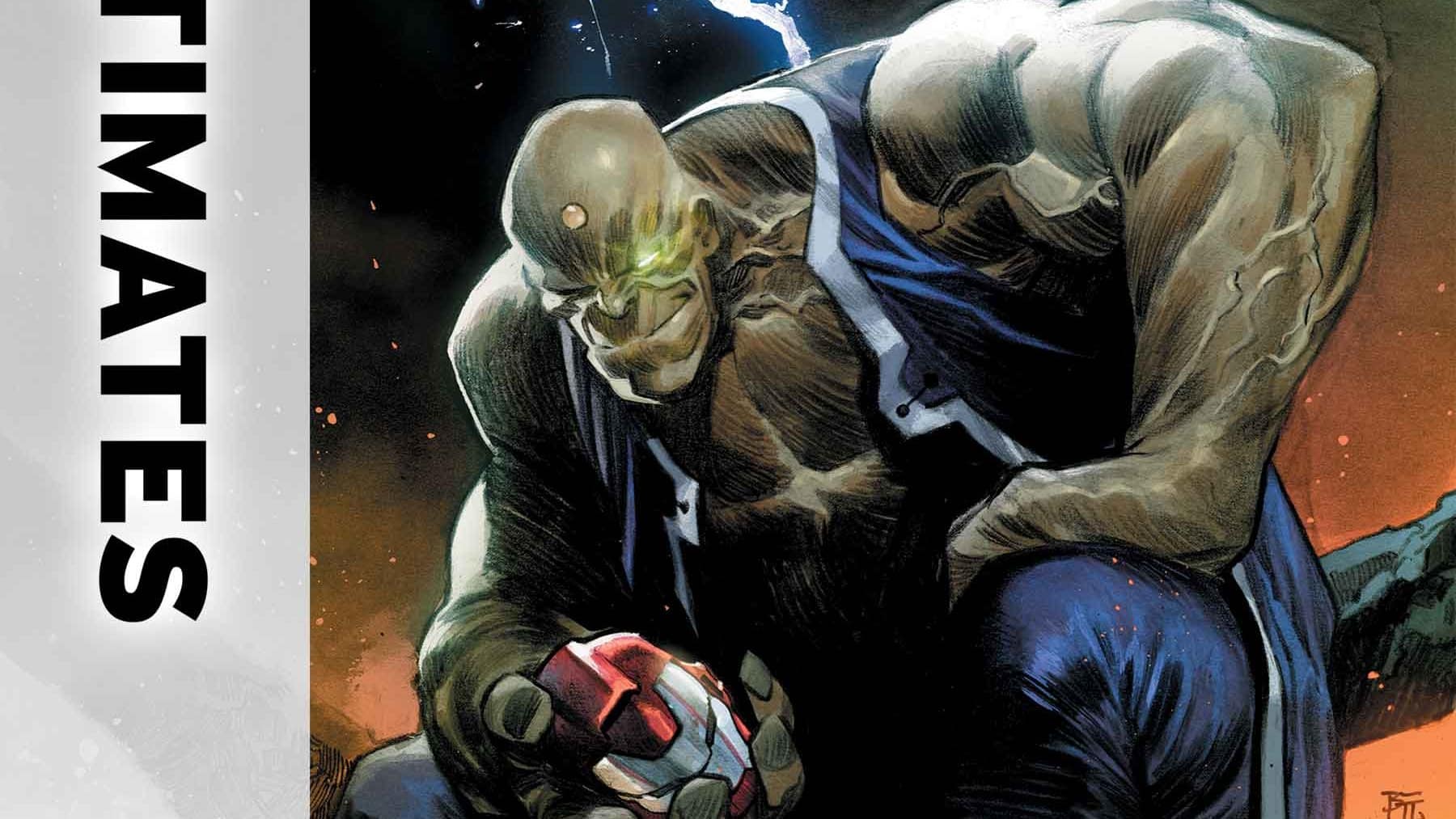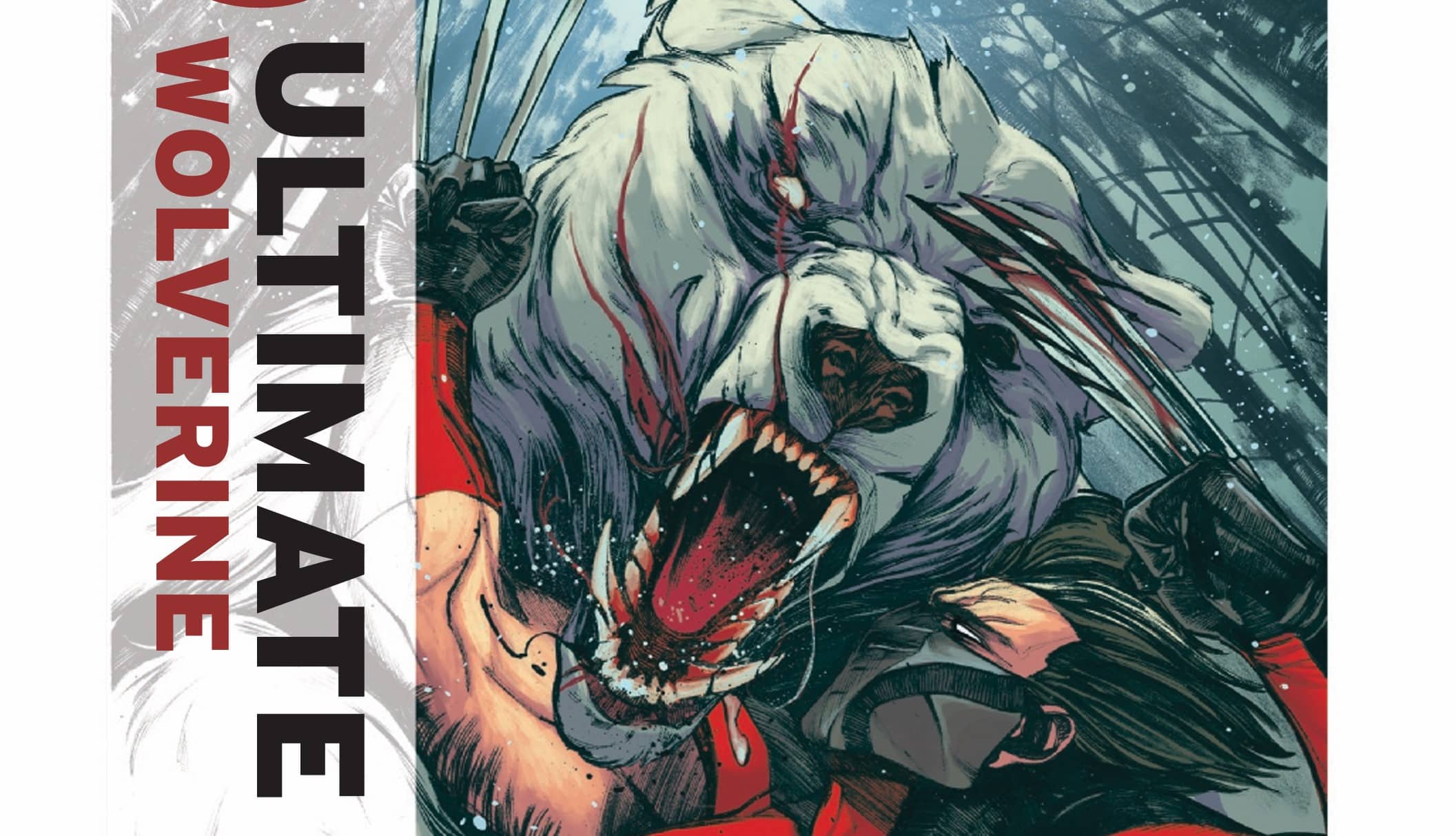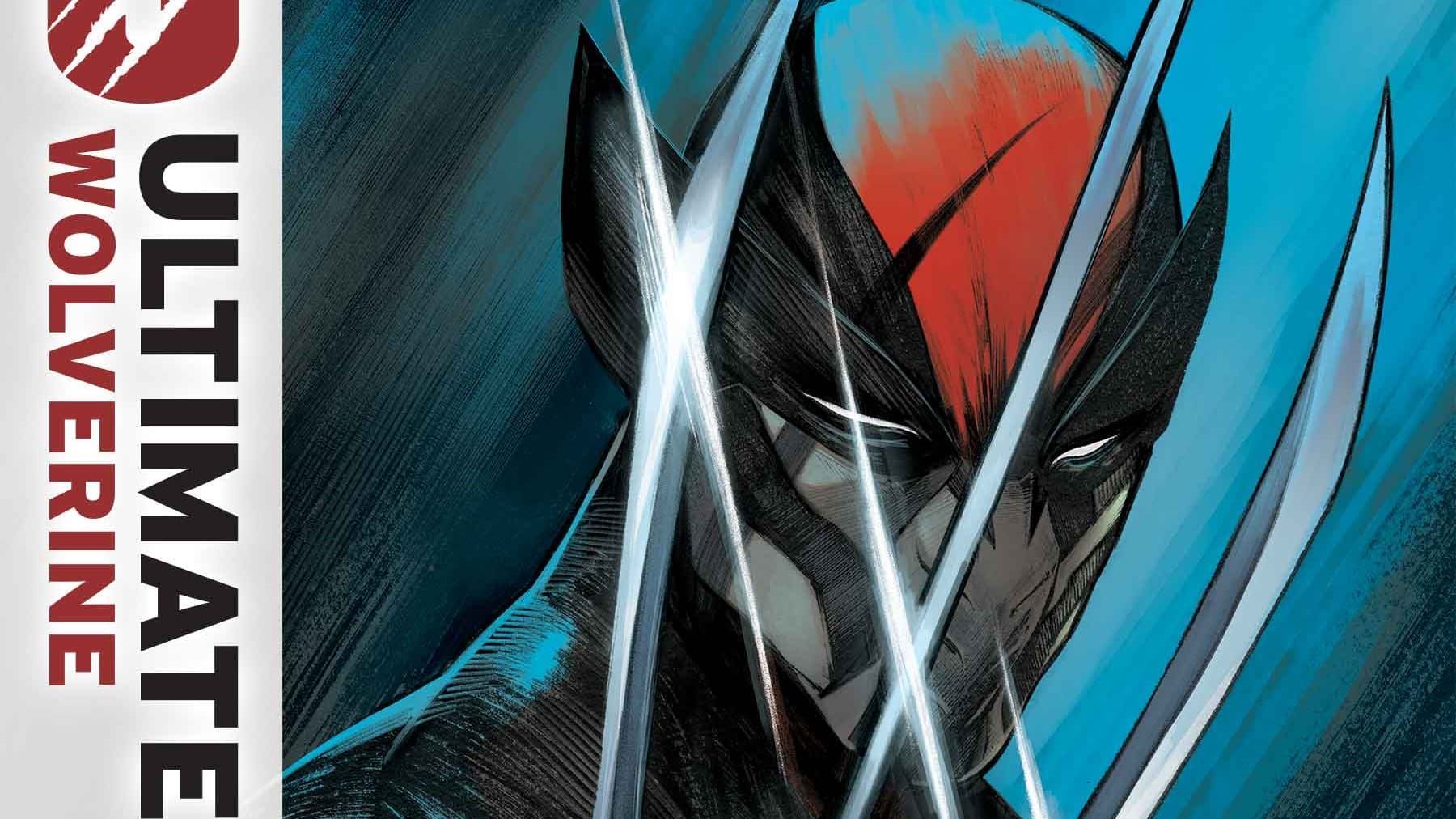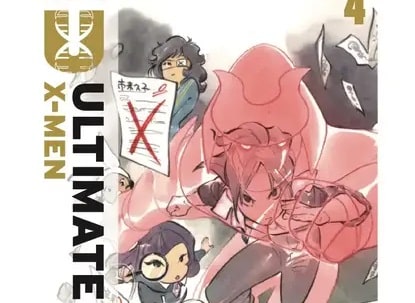The entire roster of the Ultimates unites for the first time in this high-octane, climactic conclusion of the first arc. Iron Lad has a plan to defeat the Hulk, the most powerful and imposing member of the Maker’s Council. But has he gotten his team in over their heads? The Ultimates #6 is written by Deniz Camp, drawn by Juan Frigeri, colored by Federico Blee and lettered by Travis Lanham.
There are some sights in comics you just never get sick of seeing: Batman perched moodily atop a Gotham building, Spider-Man swinging hurriedly between Manhattan skyscrapers, Ultimate Wasp exploding a dude from the inside out, retching as she emerges in a pool of blood and guts.
They are iconic images of the genre (OK, perhaps two of the aforementioned examples more so than the other) because they are a perfect distillation of the central figures inhabiting the fictional worlds they depict. While Batman sits in quiet contemplation of his solemn oath to defeat criminality, Spider-Man symbolically swings from one drama to another, and you are left to wonder whether he’s in pursuit of the Green Goblin or just late for dinner with Aunt May. Besides being a joke, and a good one at that, what does the repeating motif of Janet Van Dyne bursting forth from an unfortunate goon tell us about her, about The Ultimates generally, and the 6160 universe more broadly? We’ll explore this in more detail later on, but I’ll once again evoke Spider-Man when I say it has a lot to do with power and everything to do with responsibility.
Ultimate Calamity

The structure of the first arc of Deniz Camp and Juan Frigeri’s Ultimates run has been a series of one-shot, anthology-style issues focusing on the origins of individual team members, bookended by team-up issues. This framework isn’t just your typical “meet the team” style, it’s as fundamental to the story of The Ultimates in universe as it is to the reader. As Iron Lad says, this is the first time the Ultimates network has been assembled. Now, classic superhero story logic dictates that the team dynamic is essential to a team’s strength and collective functionality. After all, Charles Xavier didn’t have his X-Men log all of those hours in the Danger Room for nothing. The idea of a well-drilled team is about much more than skill, though: It’s a moral question of responsibility.
Let’s consider what happens in this issue. After hearing about Hulk kidnapping innocent civilians at his “Heaven” base, Tony Stark, aka Iron Lad, assembles a squad of 10 superheroes who have never met before. Juan Frigeri has Tony pull the most cocky facial expressions and superhero stances as he gets the team amped up for battle. They rock up to Hulk’s base to find him sitting peacefully preparing a cup of tea for their arrival. They go in half-cocked, with little semblance of a plan, and get their shit rocked. Iron Lad is ostensibly killed in action.
The Ultimates’ fate in this issue is a direct consequence of their approach. Camp has been playing with the duality of fate and free will since the first issue. Iron Lad and Doom’s campaign to recruit The Ultimates in the first place was rooted in the idea that those who took up the mantle in the 616 universe were somehow pre-destined for heroism. This theory was debunked quite quickly in the first issue, with many refusing the call. In fact, the recruitment of this universe’s She-Hulk and Hawkeye demonstrates the opposite: People are shaped by the world they reside in. The Maker’s fingerprints are all over this universe. Once again, the Wasp murdering people with little more remorse than a queasy stomach is evidence of this. The irresistible urge of fate is what leads Tony Stark to charge headfirst into battle, and to meet his end.
But this is not Camp’s position. The 6160 universe, the Maker’s universe without the Maker in it, leaves people free to make their own choices. Herein lies the crux and the central message of The Ultimates, and it’s a familiar one: With great power comes great responsibility. But this is a scalable philosophy. We’re not talking about Peter Parker failing to stop the person who ends up killing Uncle Ben, bringing personal tragedy onto himself. The Ultimates have placed the world and the people in it under their protection, and fail in their duty here by failing to prepare. The 21st century concept of empire is woven throughout the first six issues of The Ultimates, and it comes in sharp focus again here. Those with power have a duty of care and protection to the most vulnerable among us, and yet too often are people’s lives exchanged, sold and denied in pursuit of power and personal glory. When you wield this kind of power, arrogance, indiscipline and naivete are not acceptable. This is the tale of the first arc of The Ultimates, symbolized by Janet Van Dyne exploding dudes from the inside.
It’s also just a really good superhero story. Hey, everyone loves to see our heroes lose sometimes. It gives them something to fight back from, odds to overcome, etc. What’s great about The Ultimates #6 is that there’s no honor to be found in this defeat. A humbling? Yes. A coming of age? Almost certainly. The unintended consequences of their irresponsible actions in further solidifying Hulk’s power establish further barriers they’ll need to leap. With their figurehead gone, The Ultimates will need to regroup and focus on their power as a unit; of collectivism over individualism.
Spirituality is just good branding

Let’s talk about Ultimate Hulk. The trope of a spiritual guru as a villain is well-established throughout fiction. Whereas “classical” (as in non-contemporary fiction) was primarily preoccupied with religious spirituality, secularization in the 20th and 21st centuries has precipitated a dispersal of believers into an ever expanding menu of spirituality options. Contemporary fiction is typically more concerned with the general human need for belonging, and how alternative belief systems are created to cater for and exploit these yearnings. In a world founded on a man’s paranoia about his personal power in relation to others, it is fitting that Hulk has founded a belief system on the most evocative symbol of humanity’s capacity for annihilation: the atomic bomb.
Although Frigeri’s art can sometimes be a little static, his rendering of Hulk’s performative calm demeanor works well here. The framing of the deliberate anti-climax of The Ultimates bursting through the door to Heaven to be met by the lone figure of Hulk in repose fits the story perfectly. Even the devastating violence he dispenses onto The Ultimates is done through arcade beat-‘em-up style poses that, in combination with the insertion of narrative caption boxes naming the atomic themed “moves” he’s performing, creates a surreal contrasting effect between Banner’s zen body language and the apparent reality. It entrenches the idea of the Hulk’s spirituality being a form of branding, but it’s also clear that he believes his own hype. He compares himself to Gandhi, after all.
Camp ties this together through Hulk’s foundational maxim that social stability is achieved through fear of consequence. The fact, then, that he achieves peace through possessing the power of a nuclear arsenal renders his false spirituality utterly farcical, emphasized only by his ridiculous posturing. That’s not what really matters though. He’s unafraid to show his hand to The Ultimates because he knows they can’t exploit it. In the 6160 universe, as it is in ours, perceiving this reality is a world away from being able to influence it. The fact that it’s unclear how much autonomy his followers have implies the cult-like influence he has over them.
Camp does more than imply a parallel with our world, he directly establishes it through the phrase “peace through strength.” It’s a phrase that has been used for centuries to justify military power as a peacekeeping tool, but has been used consistently by Republican presidents from Ronald Reagan to Donald Trump to justify American foreign intervention, most famously in the “A Time for Choosing” speech by Barry Goldwater. Goldwater argued, on national television, that the peace and prosperity of the 1960s would soon end as a result not just of the rise of the Soviet Union but of national debt. He posited that the disturbance to the peace would come not only as a result of socialism abroad but at home, in particular the use of public finances, and that amassing power to ward off the “billion human beings now enslaved behind the Iron Curtain” was the only way to secure America’s future. He went on to posit that “there’s no argument over the choice between peace and war, but there’s only one guaranteed way you can have peace — and you can have it in the next second — surrender.” Using the preservation of peace to justify war has been the calling card of western powers for decades now, and there are a wealth of examples to choose from. The farcical idea that someone as powerful and predisposed to violence as the Hulk could present themselves as the universal symbol of peace is not so unbelievable. In fact, one might argue this is exactly the way America positions itself on the global stage.
What do you do, then, in the face of such power?
Hulk will undoubtedly use his influence to paint The Ultimates as the dissidents threatening the peace. As Camp has Hulk exposit through dialogue, in a world governed by the notion of “peace through strength,” the idea of a dissenting voice threatens the status quo. When the average person relies on the state to protect them, as designed by the state, the fear of an unstable state is enough of a deterrent to achieve compliance. The Ultimates face not only a battle against a superpowered being, but for the hearts and minds of a society conditioned to protect the little individual liberty they have.
The problem statement is set then. I’m excited to see how Camp explores the solution.
Buy The Ultimates #6 here. (Disclaimer: As an Amazon Associate, ComicsXF may earn from qualifying purchases.)
Jake Murray spends far too much time wondering if the New Mutants are OK. When he's not doing that, he can be found talking and writing about comics with anyone who will listen. Follow him @stealthisplanet.bsky.social.






